- What is a pallet?
Pallets are flat, wooden structures on which goods are bundled into larger, unitised loads. This improves efficiency because goods can be more easily handled, stacked, stored and transported.
Wooden pallets are generally simple in design and construction, and offer a great combination of weight, strength, durability and cost-effectiveness.
- What’s the difference between a pallet and a skid?
A pallet has both a top and bottom deck giving it extra stability. A skid only has a top deck, so it has a lower profile and is lighter in weight than a pallet.
Skid

Pallet

- Is there a standard pallet size in Australia?
Yes. The Australian standard pallet is square and measures 1165mm × 1165mm. Railways of Australia Container Express (RACE) containers are able to comfortably fit two Australian standard pallets side by side. Originally made only of hardwood, we can manufacture the same pallet design in pine.
There is no universally accepted international standard size for pallets.
- What type of pallet do I need?
With so many pallet options available, it can sometimes be difficult to work out what type of pallet is right for your needs.
We can help you select from our standard pallet sizes, build pallets to your supplied specifications, or we can customise a bespoke design. Either way, we’ll make sure that your pallet solution is fit-for-purpose, cost-effective, provides the best protection for your products, and drives your operational efficiencies.
Choosing pallets that aren’t manufactured to an acceptable standard can cause yoru business significant and costly problems, including product damage, the cost of replacing pallets, expensive downtime and potentially serious safety incidents.
With Palletmasters’ three decades of innovation and mastery, you can rely on us to find your perfect pallet solution that balances superior performance with cost-effectiveness.
- What pallet is right for my products?
There are many factors that determine what type of pallet is best suited for your products. Some of these factors include:
- The pallet’s intended use: Materials handling in automated machinery and plants, storage, shipping, export or general purpose
- What the pallet will be carrying: Expected size, load weight and type of product
- How the pallet will be moved or stored: Moved by forklift or pallet jack, storage in Australian standard or drive-in racking, stacking of loaded pallets and how they’ll be packed into trucks or shipping containers to minimise wasted space
Pallet designs can be fine-tuned according to their use:
- Transport or Shipping pallets: Usually one-trip, or non-returnable structures. Shipping pallet sizes are usually dictated by the interior dimensions of carrier equipment or intermodal containers. When transporting products, pine is more cost-effective because it weighs less than hardwood, however, if you are transporting heavier products, hardwood is sturdier and provides better protection.
- General purpose or reusable pallets: Sometimes called capture or pool pallets, these are suitable for continuous use in materials handling, warehousing and shipping.
- Special-purpose pallets: These are customised for a particular product or service.
Palletmasters can help you make the correct choice.
- What’s better for my needs – hardwood or pine pallets?
One of the considerations when selecting pallets is whether they are made from hardwood, pine or a combination of both. The physical structure between the two types of timber is quite different.
Pine or softwood pallets
Pine pallets are the most commonly used timber pallets in Australia. Pine timber is readily available from sustainable pine plantations, is cheaper than hardwood and is a versatile timber for pallet design. Less dense and lighter than hardwood, pine pallets are a more cost-effective option for single use shipping purposes and can still withstand reasonable weights.
Hardwood pallets
Hardwood pallets are used for their strength and durability. Hardwood timber pallets are higher in density than pine, making them less susceptible to moisture issues and able to take heavier loads. Harwood timber is naturally more resistant to decay. Due to increasing scarcity, hardwoods are generally more expensive, but they offer a more durable, longer-lasting option for ongoing use.
- Is buying wooden pallets harmful to the environment?
Pine and hardwood timber are both 100% renewable, reusable and recyclable products. The most commonly used alternative are plastic pallets, however, which are made from oil and gas that are limited fossil fuels.
Pallets are manufactured from lower grades of timber from woods and mill residue, improving the percentage recovery of timber from a log.
Palletmasters recycles our sawdust and timber offcuts to be used as a fuel source or as organic material for mulch.
- What’s the difference between a 2-way and a 4-way pallet?
Pallets can be designed with either 2-way or 4-way entry. Entry refers to the number of sides with openings for insertion by materials-handling equipment, such as the tynes on forklifts or pallet jacks.
2-way entry or bearer pallets
These are the most commonly used pallets in Australia. They generally have an internal frame of three or more parallel pieces of timber, called bearers. Top and bottom deck boards are nailed to the bearers to form the pallet structure.
Forklift tynes are able to enter the pallet from two sides, i.e. parallel to the bearers.
Partial 4-way entry or notched bearer pallets
This is not a common design in Australia. This 4-way entry design has notched bearers and is sometimes known as a partial 4-way entry.
4-way entry or block pallets
Block pallets utilise a bow in the internal frame that’s made from a combination of a thin board (or stringer) and blocks. The top and bottom deck boards are nailed to the bow to form the pallet structure.
The use of blocks in the construction means that the pallet can be moved from any of the four sides.
Skids
A skid is a single-deck, 2-way entry pallet with a top deck but no bottom deck.
- Can I use a pallet jack to move my pallets?
How you intend to move your pallets will have an impact on the design.
Forklift tynes are thinner with adjustable spacing, however, this is not the case for pallet jacks. If you’re moving pallets with a pallet jack, we’ll alter our design accordingly.
- What is the load bearing capacity of a pallet?
Load bearing is a significant safety consideration because wooden pallets can be susceptible to damage from the elements and from overuse.
Load bearing capacity can also be impacted by how you use your pallet.
Static load: refers to when weight is placed on a pallet at rest, for example stored on the floor.
Dynamic load: refers to the weight that is placed on a pallet and then put in motion, for example while moving your goods with a forklift.
Racking load: for when a pallet is placed in a racking system. There is significant difference between the load bearing capacity between Australian standard and drive-in racking.
A pallet design would return three different load bearing capacities when analysed against the above three styles of use.
Palletmasters takes safety extremely seriously, and we’ll consider a range of factors before advising on the best pallet design for your requirements. Using a pallet design software program, we can analyse nominal load capacities under different scenarios and customise designs to suit.
- What pallets fit into ISO shipping containers?
Pallet dimensions are often dictated by the interior dimensions of carrier equipment or standardised shipping (intermodal) containers.
Palletmasters carries three different size pallets in stock to suit three different ISO shipping containers:
ISO container Pallet dimensions (mm) Pallet identification General purpose / dry freight 1150 x 1150 Type 3, 4 and 5 Refrigerated, also known as reefers 1100 x 1100 Type 2 Freezer / Chiller 1016 x 1016 Type 1 But these are just the start, Palletmasters can design and manufacture a customised pallet solution to whatever specifications suit your products and business.
- What is a Euro (EUR) pallet or EPAL pallet?
This is the standard European pallet as specified by the European Pallet Association (EPAL). Four common sizes of EUR-pallets are:
EUR pallet type Dimensions (W × L) mm EUR 1 800mm × 1200mm EUR 2 1200mm x 1000mm EUR 3 1000mm x 1200mm EUR 6 800mm x 600mm EPAL awards licences to producers that are able to meet their requirements. Because Australia is not part of the European open pooling system for pallets, Palletmasters has not sought EPAL accreditation. We can manufacture pallets to these specifications, however, they won’t bear the accredited EPAL mark.
- What are wooden crates used for?
A wooden crate is typically used to transport or store large and heavy items, or items that require an extra level of protection.
- What are the different types of wooden crates?
There are many wooden crate designs, but the three most common are:
1. Solid crates: These are completely or almost completely enclosed with material such as timber boards or plywood. The boards are butted close together with minor gaps in between to allow for expansion. Solid crates offer optimum protection for your products during transit and storage.
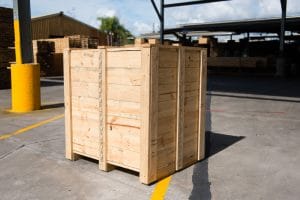
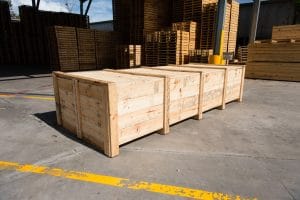
2. Gabled crates: Also called Hit and Miss crates, these are constructed with gaps between the timber boards which gives an open-slatted appearance. The gap between the boards is usually not greater than the width of the sheathing boards. We design gabled crates at ~60% coverage, but we can adjust this to suit your needs. Gabled crates are useful when improved ventilation is needed, or to reduce the load weight while still providing good protection for goods.
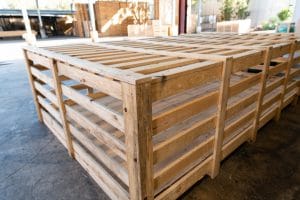
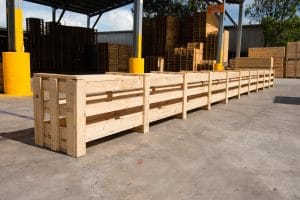
3. Frame crates: These are crates with no sheathing boards. They consist of a skeletal structure with no material added for surface or anti-theft protection.
- What else do I need to know about crates?
If you are exporting your goods in a crate, we heat treat in our onsite kiln to comply with export regulations.
All of our wooden crates have thick bottom bearers to provide forklift access for lifting.
All crates also come with a loose lid, but you can opt for no lid if you want.
If you need additional access for packing, we can customise the crate design to have either a loose side or end.
- What type of crate do I need?
To work out what type of crate you need, we assess factors including the size and weight of your items, the bearer placement requirements, access points and what level of protection is required.
Talk to Palletmasters about your specific transport or storage requirements, and we’ll customise your ideal crate solution.
- Do you hold any wooden crates in stock?
No. All of our crates are made to order and designed for your specific product and packaging requirements.
- How will my crates be delivered?
Palletmasters can deliver your crates either fully assembled with a loose lid and ready for immediate use, or flat-packed for you to assemble at your site. Flat-packed crates offer a more cost-effective delivery.
- What is timber dunnage?
The term dunnage refers to pieces of timber used to support and protect items from potential damage during transportation, packing and storage. Dunnage may be used to strap items together or to separate them to prevent any slippage or jostling during transit.
- What’s the difference between hardwood and pine (softwood) dunnage?
Pine dunnage is most commonly used as it is more cost-effective than hardwood, and also less dense, so it’s lighter in weight
Hardwood dunnage is more durable and longer lasting, so it can be a better option for ongoing use
- What is strap grooved timber?
Strap grooving is where a channel of timber is removed from the length of a piece of timber to allow the secure placement of strapping for securing loads.
Palletmasters can strap groove timber with a channel of 19mm and 38mm, depending on your requirements.
- What size is your timber dunnage?
We hold a high volume of the more common timber sizes used in pallet construction. We can supply dunnage in a variety of sizes, and we can cut to specific lengths if required.
If you need a different size of timber dunnage, talk to Palletmasters and we’ll customise your ideal solution.
- What is ISPM 15?
All wooden pallets and crates that are exported, must comply with the International Plant Protection Convention (IPPC) requirements.
IPPC is an international treaty that is administered by the Food and Agriculture Organization (FAO).
The IPPC guided the development of the 'International Standards for Phytosanitary Measures Publication No. 15 (2019): Regulation of Wood Packaging Material in International Trade' (ISPM 15).
ISPM 15 is a standard for certification and it sets out criteria for regulating wood packaging material used in international trade. It aims to prevent the global spread of invasive species of insects and plant diseases.
Palletmasters is accredited with ISPM15, so you can be confident that your goods will be comply with export requirements.
- Can I use your pallets, crates and dunnage to export my products?
Yes. Palletmasters is a certified heat treatment manufacturer. We can build and heat treat pallets and crates to meet the ISPM15 requirements for shipping wood packaging overseas.
Palletmasters is regularly audited by the Australian Wood Packaging Certification Scheme (AWPCS) to verify that we continue to meet the ISPM 15 standard for exports.
- What is required to comply with ISPM 15?
To comply with ISPM 15, timber packaging must:
- Meet the ISPM 15 bark tolerance requirements
- Have been subjected to an ISPM 15-approved treatment by an appropriately certified treatment provider or manufacturer
- Have been marked appropriately
Palletmasters heat treats our export wood packaging products in our onsite kiln. Heat treating requires that the wood must be heated to achieve a minimum core temperature of 56 °C for at least 30 minutes.
- How is ISPM 15 compliant timber packaging identified?
We apply an IPPC “HT” mark on two sides of each pallet, skid, crate or dunnage. This approved IPPC stamp or stencil clearly certifies that the product has been treated and complies with export ISPM 15 regulations.
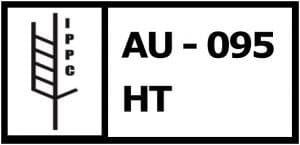
- What products does ISPM 15 apply to?
ISPM 15 applies to raw wood packaging material made of both pine and hardwood. This includes pallets, skids, crates, bins, dunnage and pallet collars.
Engineered wood products, such as plywood, particle board, or veneer are considered low risk, and are exempt from ISPM 15 regulations.
- How long is ISPM 15 treatment effective for?
According to the standard, ISPM 15-marked timber packaging remains compliant provided that no alterations are made to the packaging.
ISPM 15 treatments only control pests present at the time of treatment and do not offer permanent protection against post-treatment re-infestation.
- Where can I find more information about ISPM 15?
For more information see ISPM15 for Exports.
Timber
- Where do you source your timber?
Palletmasters sources sustainable, well-managed plantation timber from suppliers that are certified to meet the requirements of Australian Standard 4707: 2014 - Chain of Custody for Forest Products (AS 4707).
The Responsible Wood Certification Scheme for Chain of Custody (AS 4707) certification, tracks forest-based products from sustainable sources to the final product.
- What is the discolouration in the timber?
Many stains and all forms of decay or rot are caused by fungi that grow on and in wood. Blue stain, or sap stain, is the most common and it looks like mould. It occurs in the sapwood of many species and results in a mottled or streaked bluish or greyish stain. A stain of this type does not seriously affect wood strength.
- Is your timber chemically treated?
We do not use chemically treated pine or hardwood. Treated timber has been permeated with a chemical solution that gives it a long-term resistance to decay, insects and other deteriorating factors. It is generally used for external applications such as decking, cladding, posts and poles.
Delivery
- Do you deliver?
Yes. Palletmasters knows that timing is everything when it comes to keeping your products and operations moving. Our two semi-trailers have extended flatbed trailers with capacity to carry 24 standard pallet spaces per load (approximately 470 pallets). We deliver to anywhere in south-east Queensland for orders of 100 or more standard sized pallets (i.e. 1165mm x 1165mm).
For larger pallets, we deliver where the spaces are more than 6 pallet spaces. Any partly used pallet space on a trailer, due to an oversized pallet, will be charged as a full pallet space.
For smaller volume orders, we use a local, competitively priced delivery company.
If you have a preferred freight company, we can call them on your behalf to arrange pick up.
Delivery options are chosen based on your unloading preference, yard size and layout.
- What is a pallet space?
A standards pallet space is generally 1200mm long and 1200mm wide, and based on the size of an Australian standard pallet (i.e. 1165mm x 1165mm).
Trucks have a tray of 2.4m, allowing them to carry two pallets side by side.
